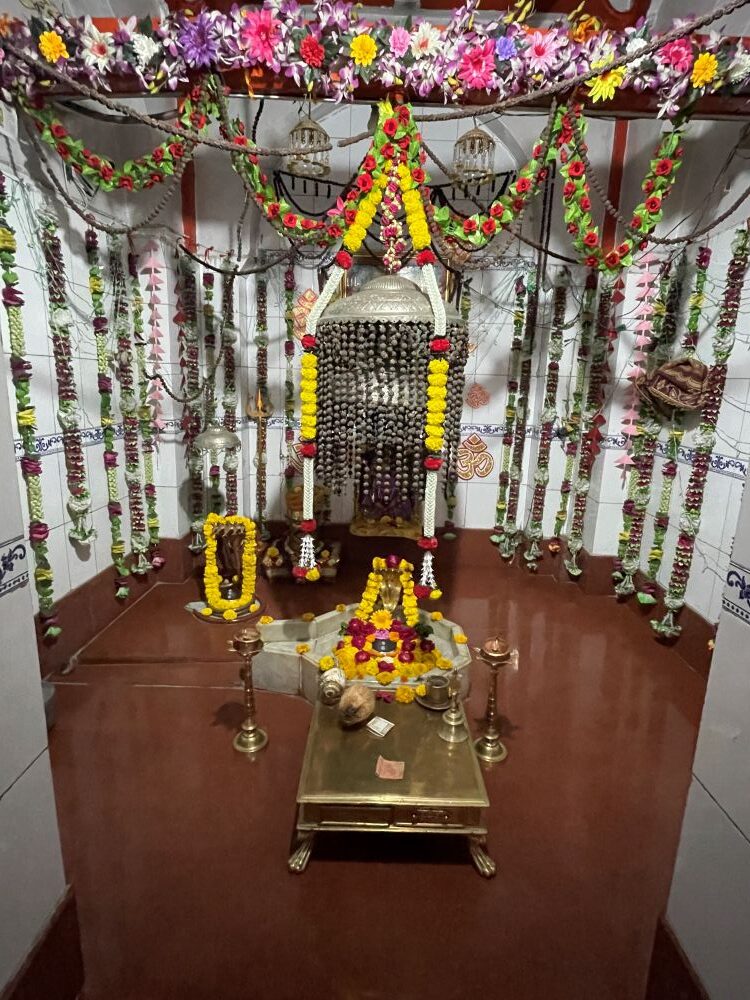 Located near Rajpipla, which was once a capital city founded in the 14th century AD by a prince of the Paramara Rajput dynasty, the Nandikeshwar Mahadev Temple derives its name from Nandi, the beloved attendant of Lord Shiv. Set amidst the Vindhyachal mountain range on the sacred banks of the Karjan (Karatya) River, this ancient temple is built in the Vesara style of architecture. Devotees hold the Shivalinga here in high reverence and believe it to be especially powerful. Consequently, large numbers of devotees visit to offer worship. Beside this temple stands another shrine dedicated to Navadurga (the Nine Forms of the Goddess Durga).
Located near Rajpipla, which was once a capital city founded in the 14th century AD by a prince of the Paramara Rajput dynasty, the Nandikeshwar Mahadev Temple derives its name from Nandi, the beloved attendant of Lord Shiv. Set amidst the Vindhyachal mountain range on the sacred banks of the Karjan (Karatya) River, this ancient temple is built in the Vesara style of architecture. Devotees hold the Shivalinga here in high reverence and believe it to be especially powerful. Consequently, large numbers of devotees visit to offer worship. Beside this temple stands another shrine dedicated to Navadurga (the Nine Forms of the Goddess Durga).
The sixth chapter of the Shiv Purana contains the story of Nandikeshwar. According to this legend, Nandi was born as the son of Sage Shilada, who had performed intense penance dedicated to Lord Shiv. Pleased by his devotion, Shiv manifested before the sage and said, “I am regarded as the father of the entire universe; however, I grant you this boon – I shall be born as your son, not from any womb and my name shall be Nandi.” Accordingly, Lord Shiv incarnated in the form of Nandi as the son of Sage Shilada. At birth, he appeared holding a trident, with matted hair on his head. Later, he assumed a more common form. Lord Shiv also granted Nandi immortality.
By Shiv’s blessing, Nandi was bestowed with three eyes and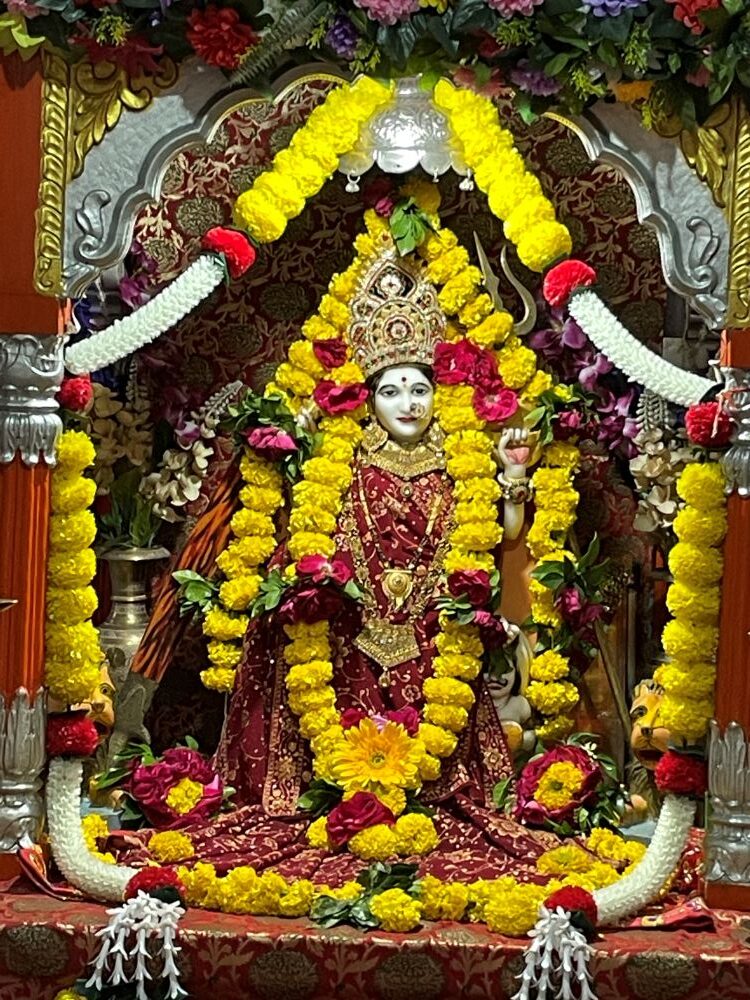 ten arms. As the Shiv Purana narrates, when Nandi expressed his wish, Shiv chose him as his mount (vahana) and made him the leader of Shiv’s attendants (ganas). Nandi’s marriage took place with Suyasha, the daughter of the Maruts. Local lore claims that approximately 1,650 years ago, it was Nandi himself who established the Shivalinga at this site.
ten arms. As the Shiv Purana narrates, when Nandi expressed his wish, Shiv chose him as his mount (vahana) and made him the leader of Shiv’s attendants (ganas). Nandi’s marriage took place with Suyasha, the daughter of the Maruts. Local lore claims that approximately 1,650 years ago, it was Nandi himself who established the Shivalinga at this site.
This temple is situated in Jitnagar, around four kilometers from Rajpipla. Historically, Rajpipla was founded when Prince Chhokarana of the Paramara Rajput dynasty from Ujjain arrived in this region of Gujarat with the aim of establishing his own kingdom. He set up his first capital in a remote village near the Karjan River named Nandipur (present-day Nandod). He then expanded his rule throughout the surrounding areas. Soon afterward, he shifted the capital to Rajpipla in the Satpura range – what is now referred to as Old Rajpipla. The current city of Rajpipla developed later and Nandod (formerly Nandipur) is now part of it. Scholars believe that the original name Nandipur is preserved in homage to Nandikeshwar Mahadev.
The existing structure of the temple is believed to date to the 16th century, making it about 500 years old. Many elements – such as intact idols, the dome, stonework, doorways, archesand carvings – attest to its antiquity. Over time, the temple had fallen into disrepair, so it was renovated around 1960. While the original architecture was 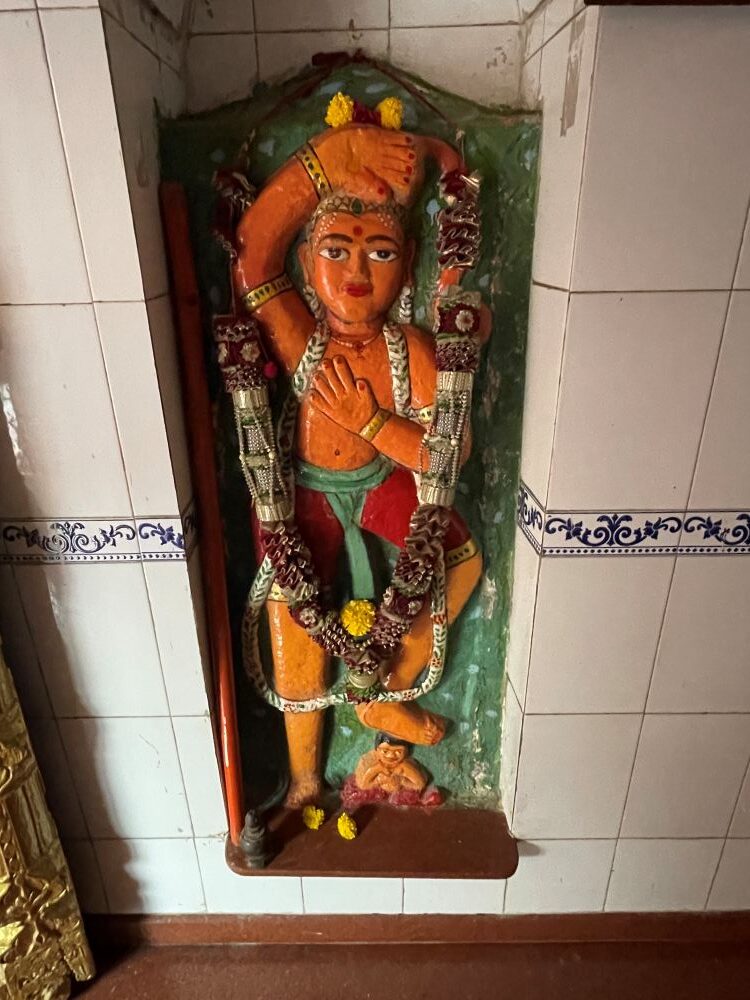 preserved, the interior and exterior areas were refurbished. During this renovation, a new idol of Navadurga Mata was installed alongside her throne. The courtyard dedicated to Sati Mata was also renovated.
preserved, the interior and exterior areas were refurbished. During this renovation, a new idol of Navadurga Mata was installed alongside her throne. The courtyard dedicated to Sati Mata was also renovated.
Surrounded by agricultural fields and located near a main road, the temple complex features a well-maintained garden with numerous trees. A wrought-iron gateway in the outer wall leads into the compound, facing the main entrance hall (mukhamandap). On its roof is an idol of Ganesha flanked by two lion sculptures. On both sides of the broad entrance way, there are paintings of elephants bearing howdahs (seats), ushering visitors into an inner veranda. A short distance from there stands the temple structure itself. Shrines for Nandikeshwar Mahadev and Navadurga Mata stand side by side. It appears that the Navadurga shrine was joined to the original temple at a later time. A newer darshan mandap (hall for devotees) has been added in front of these shrines.
Within the assembly hall (sabhamandap) of the Nandikeshwar Mahadev Temple is a marble idol of Nandi. In front of Nandi is a carved tortoise figure. To the right of the sabhamandap entrance, set into the wall, is an ancient four-armed idol of Goddess Durga. One of her right hands wields a sword; another hand holds a mace.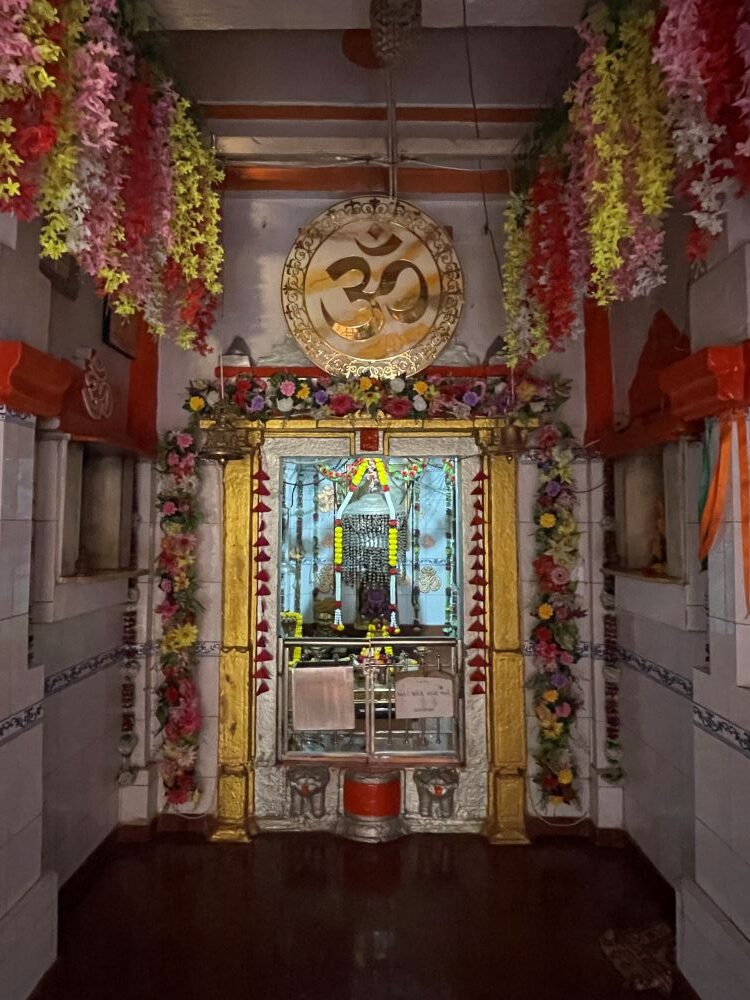 With one hand, she grasps the hair of a demon and one foot rests on a tiger. According to the temple priest, this was the original idol from the Navadurga shrine, which was replaced with a new idol during renovaions.
With one hand, she grasps the hair of a demon and one foot rests on a tiger. According to the temple priest, this was the original idol from the Navadurga shrine, which was replaced with a new idol during renovaions.
On the left side of the sabhamandap stands a tall niche containing an ancient standing idol of Lord Hanuman, depicted with one hand on his head and the other on his chest, crushing a demon figure under an upraised foot. Above this idol are photographs of priests and revered saints associated with the temple. Another niche in the hall houses a portrait of Lord Dattatreyaand yet another contains a second Hanuman idol.
In the innermost sanctum (garbhagriha) stands the Shivalinga of Nandikeshwar Mahadev, surrounded by a raised marble platform (shalunka). Over the linga, a brass serpent idol is positioned, with a silver canopy (chhatra) above it. Multiple rudraksha garlands dangle from the canopy, as do numerous flower garlands from the ceiling. Behind the Shivalinga, in a small shrine, is an idol of Goddess Parvati, beside which stands a smaller Shiv lingam. Coiled around this smaller lingam is a five-headed brass serpent with its hood raised protectively. Next to it is a brass mask of Nandikeshwar wearing a traditional Gujarati turban.
In the adjacent Navadurga Temple, a tall marble shrine 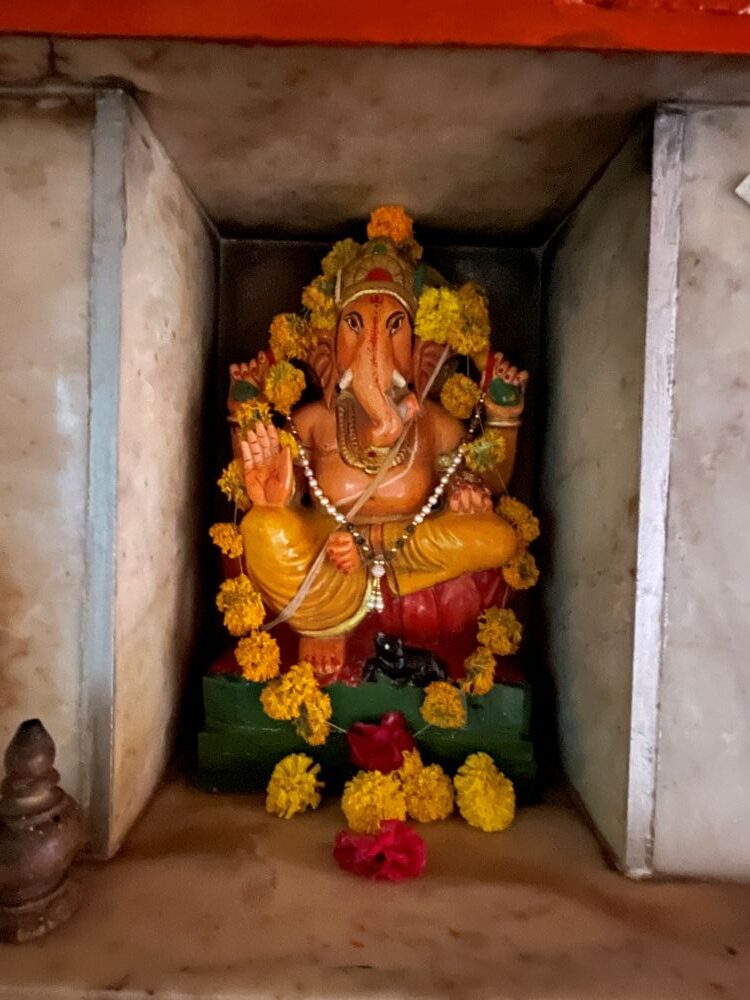 (devli) supports the marble idol of Navadurga, seated in a silver makhar (decorative arch). The sanctum of the Navadurga shrine and the sabhamandap of the Nandikeshwar Temple each have a domed (gumataakar) shikhara. Over the garbhagriha of the Nandikeshwar Temple rises a tall spire in the urushringa style.
(devli) supports the marble idol of Navadurga, seated in a silver makhar (decorative arch). The sanctum of the Navadurga shrine and the sabhamandap of the Nandikeshwar Temple each have a domed (gumataakar) shikhara. Over the garbhagriha of the Nandikeshwar Temple rises a tall spire in the urushringa style.
Devotees can have darshan (viewing of the deity) of the Shivalinga from 6 AM to 9 PM. Navadurga Mata can be worshiped from 6 AM to 1 PM and again from 2:30 PM to 9 PM. Aarti (the ritual of waving lamps) takes place at 6 AM and 7 PM. Naivedya (food offering) is made at 12:30 PM daily. Rudrabhishek (ceremonial bathing of the Shivalinga) and Chandi Paath (reading of scriptures dedicated to the Goddess) are performed regularly. The Nandikeshwar Mahadev Trust occasionally organizes Vishnu Yagas, Datta Yagas, Maharudra Yagas, readings of the Shrimad Bhagavatam, recitations of the Sunderkand and similar events. A special Navachandi Yagna is held during the month of Chaitra. Prominent spiritual leaders such as Jagadguru Shankaracharya Swaroopanand Saraswati Ji Maharaj, Vats Peethadhishwar Aniruddhacharya Ji, Mast Raghav Maharaj, Jagdishgiri Ji Maharaj and Venkateshacharya Ji have visited and worshipped the Shivalinga here.
On Mahashivaratri, a grand fair (yatra) is held at the temple. Key rituals of the day include the Mahapuja (major worship) of the Shivalinga, Prahar Puja (offered every three hours), Panchvakra Puja, Homa-based Laghu Rudra, the offering of a thousand bel leaves and a Navachandi Yagna. Devotional singing of the Shiv Mahima Stotra (hymns glorifying Lord Shiv), evening bhajans and nighttime Garba dancing are also organized. A ceremonial chariot procession of Lord Shiv travels from this temple to the nearby Maninageshwar Temple.
Throughout the month of Shravan, the temple conducts the Chintamani Partheshwar Puja every day. Each day, Lord Shiv is adorned with a new form of decoration. During this month, learned Brahmins ritually fashion small Shiv lingams out of pure clay and worship them. At the end of Shravan, these Partheshwar lingams are immersed. On the last Monday of Shravan, a Laghu Rudra Puja and ‘Brahmbhojan’ are organized at the temple.
